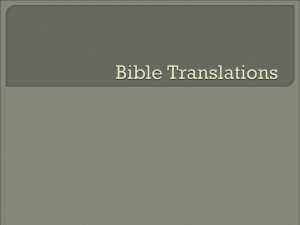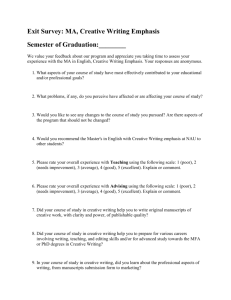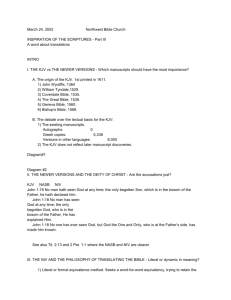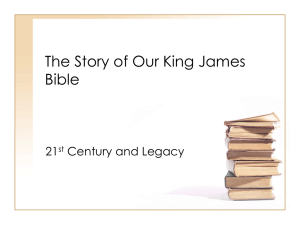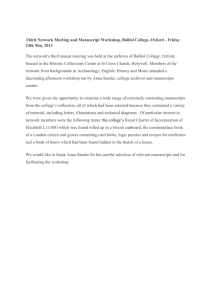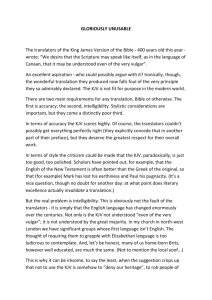Which version of the Bible should believers use?
advertisement
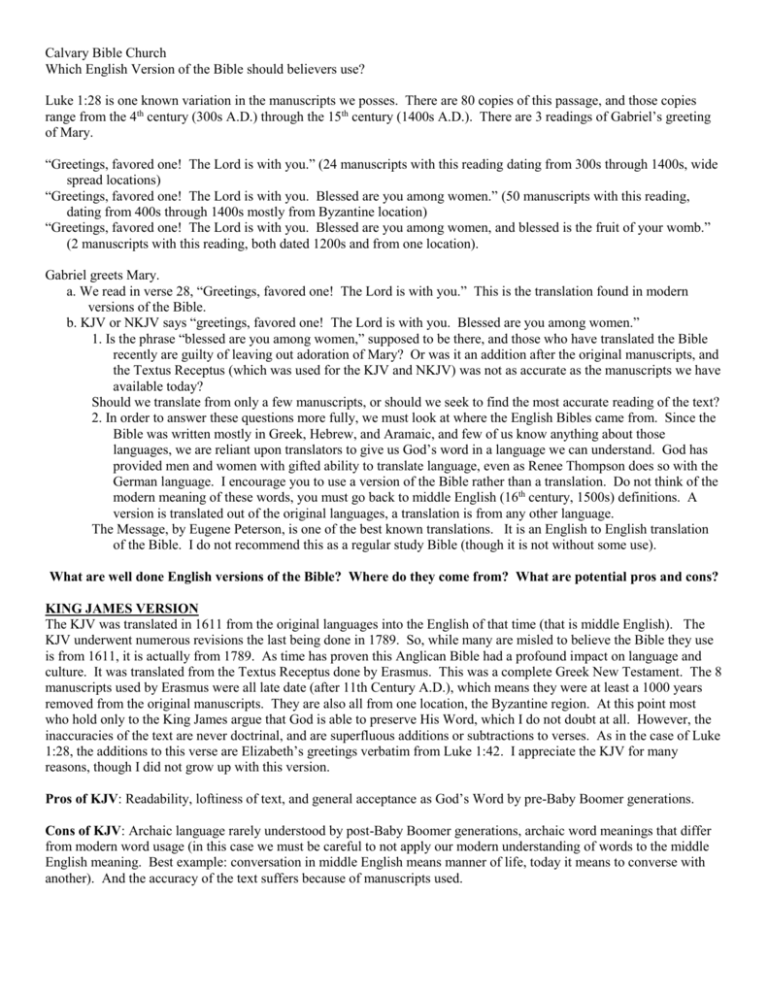
Calvary Bible Church Which English Version of the Bible should believers use? Luke 1:28 is one known variation in the manuscripts we posses. There are 80 copies of this passage, and those copies range from the 4th century (300s A.D.) through the 15th century (1400s A.D.). There are 3 readings of Gabriel’s greeting of Mary. “Greetings, favored one! The Lord is with you.” (24 manuscripts with this reading dating from 300s through 1400s, wide spread locations) “Greetings, favored one! The Lord is with you. Blessed are you among women.” (50 manuscripts with this reading, dating from 400s through 1400s mostly from Byzantine location) “Greetings, favored one! The Lord is with you. Blessed are you among women, and blessed is the fruit of your womb.” (2 manuscripts with this reading, both dated 1200s and from one location). Gabriel greets Mary. a. We read in verse 28, “Greetings, favored one! The Lord is with you.” This is the translation found in modern versions of the Bible. b. KJV or NKJV says “greetings, favored one! The Lord is with you. Blessed are you among women.” 1. Is the phrase “blessed are you among women,” supposed to be there, and those who have translated the Bible recently are guilty of leaving out adoration of Mary? Or was it an addition after the original manuscripts, and the Textus Receptus (which was used for the KJV and NKJV) was not as accurate as the manuscripts we have available today? Should we translate from only a few manuscripts, or should we seek to find the most accurate reading of the text? 2. In order to answer these questions more fully, we must look at where the English Bibles came from. Since the Bible was written mostly in Greek, Hebrew, and Aramaic, and few of us know anything about those languages, we are reliant upon translators to give us God’s word in a language we can understand. God has provided men and women with gifted ability to translate language, even as Renee Thompson does so with the German language. I encourage you to use a version of the Bible rather than a translation. Do not think of the modern meaning of these words, you must go back to middle English (16th century, 1500s) definitions. A version is translated out of the original languages, a translation is from any other language. The Message, by Eugene Peterson, is one of the best known translations. It is an English to English translation of the Bible. I do not recommend this as a regular study Bible (though it is not without some use). What are well done English versions of the Bible? Where do they come from? What are potential pros and cons? KING JAMES VERSION The KJV was translated in 1611 from the original languages into the English of that time (that is middle English). The KJV underwent numerous revisions the last being done in 1789. So, while many are misled to believe the Bible they use is from 1611, it is actually from 1789. As time has proven this Anglican Bible had a profound impact on language and culture. It was translated from the Textus Receptus done by Erasmus. This was a complete Greek New Testament. The 8 manuscripts used by Erasmus were all late date (after 11th Century A.D.), which means they were at least a 1000 years removed from the original manuscripts. They are also all from one location, the Byzantine region. At this point most who hold only to the King James argue that God is able to preserve His Word, which I do not doubt at all. However, the inaccuracies of the text are never doctrinal, and are superfluous additions or subtractions to verses. As in the case of Luke 1:28, the additions to this verse are Elizabeth’s greetings verbatim from Luke 1:42. I appreciate the KJV for many reasons, though I did not grow up with this version. Pros of KJV: Readability, loftiness of text, and general acceptance as God’s Word by pre-Baby Boomer generations. Cons of KJV: Archaic language rarely understood by post-Baby Boomer generations, archaic word meanings that differ from modern word usage (in this case we must be careful to not apply our modern understanding of words to the middle English meaning. Best example: conversation in middle English means manner of life, today it means to converse with another). And the accuracy of the text suffers because of manuscripts used. NEW AMERICAN STANDARD The New American Standard I preach from is the published work of 1995 by the Lockman foundation. They began the translation project in 1959. It was done with the same principles as the King James Version of word for word translation, and placed in understandable language. The KJV and NASB are wonderful versions of the Bible. Used wide age varied, location varied, and author varied manuscripts as text for translations. Pros of NASB: Accuracy of the text. Understandable language for post-Baby Boomer generations. Cons of NASB: Cons readability is hindered by extreme accuracy. Word order is sometimes confusing. NEW KING JAMES VERSION The New King James Version was a version I preached out of for 3 years. It is accurate and readable. Printed by Thomas Nelson in 1982, it was begun in 1975. It is based upon the Textus Receptus. Translators did update the language of the King James to modern English. Pros of NKJV: Language is simple to understand, and is very readable. Cons of NKJV: Accuracy of the text. NEW INTERNATIONAL VERSION The New International Version is a version I love, because it is the version I grew up with. It was completed in 1978 with revisions to the modern printing in 1983, the year I was born. It differs from the KJV and NASB in that it was translated using the principle of dynamic equivalent. Being faithful to the text, while being relevant to the meaning. Accurate and readable, it is translated at an eighth grade reading level. Obviously this has many benefits. Uses widespread manuscripts. Pros of NIV: Almost anyone can understand the language. Flows well. Cons of NIV: Dynamic equivalent translation gives too much room for interpretation done by translators. Accuracy suffers without word of word translation. Some believe it reads too easily placing it more on the level of a novel than God’s Word (something I have been told, to which I ask: is God’s Word supposed to be a book understood, or an idol we uphold?). ENGLISH STANDARD VERSION My current love of versions lands upon the English Standard Version. It was produced by Crossway in 2003. This version carries the flow found in the King James, with the language of the 21st Century. Since I do not speak middle English, this greatly appeals to me. I have been using this Bible for 5 years now, and can say it is incredible. I have used this in my sermons for 3 years. Like the NIV and NASB, the ESV uses widespread manuscripts. Pros of the ESV: Accurate and readable, easily flows. Cons of the ESV: Like the NIV there are verses left out. Though the evidence they should not be there is strong, the verses have been established since the 1200s by Stephen Langton. As a result, leaving out a verse (and including that verse in the foot note) is slightly strange, and can be problematic for many, hence I do not preach solely from this version. Along with these there are other well done versions and translations, and terrible ones (such as the New World Translation and other bad translations). Choosing a solid Bible in English is a preference. You are not a better Christian if you use the King James, the New International Version, or the New American Standard. God did not inspire the translations, but inspired the original manuscripts, though He has been gracious to continue to provide an accurate testimony of His Word. The testimony of the manuscripts found since the early 20th century attest to the fact that the Textus Receptus, though a wonderful gift from Erasmus, was not as accurate as what we have available today. Since God has been faithful to allow us to find more and more manuscripts from widespread locations and older dates, we should make use of them in our desire to have God’s Word. Remember 1st Thessalonians 5:21 “But test everything, hold fast what is good.” (ESV) This would include our preferences, prejudices, and preconceptions.

